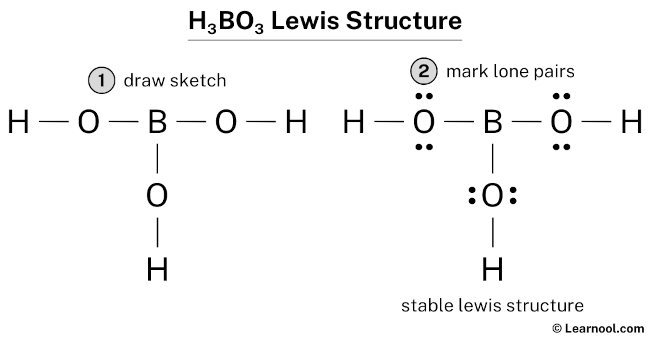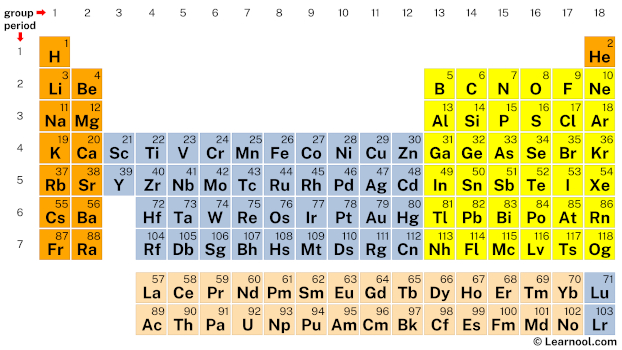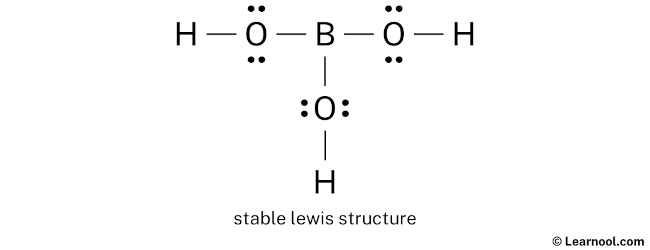
H3BO3 (boric acid) has three hydrogen atoms, one boron atom, and three oxygen atoms.
In H3BO3 Lewis structure, there are three single bonds around the boron atom, with three oxygen atoms attached to it, and each oxygen atom is attached with one hydrogen atom. And on each oxygen atom, there are two lone pairs.
Steps
Use these steps to correctly draw the H3BO3 Lewis structure:
#1 First draw a rough sketch
#2 Mark lone pairs on the atoms
#3 Calculate and mark formal charges on the atoms, if required
Let’s discuss each step in more detail.
#1 First draw a rough sketch
- First, determine the total number of valence electrons

In the periodic table, hydrogen lies in group 1, boron lies in group 13, and oxygen lies in group 16.
Hence, hydrogen has one valence electron, boron has three valence electrons, and oxygen has six valence electrons.
Since H3BO3 has three hydrogen atoms, one boron atom, and three oxygen atoms, so…
Valence electrons of three hydrogen atoms = 1 × 3 = 3
Valence electrons of one boron atom = 3 × 1 = 3
Valence electrons of three oxygen atoms = 6 × 3 = 18
And the total valence electrons = 3 + 3 + 18 = 24
Learn how to find: Hydrogen valence electrons, Boron valence electrons, and Oxygen valence electrons
- Second, find the total electron pairs
We have a total of 24 valence electrons. And when we divide this value by two, we get the value of total electron pairs.
Total electron pairs = total valence electrons ÷ 2
So the total electron pairs = 24 ÷ 2 = 12
- Third, determine the central atom
Here hydrogen can not be the central atom. Because the central atom is bonded with at least two other atoms, and hydrogen has only one electron in its last shell, so it can not make more than one bond.
Now we have to choose the central atom from boron and oxygen. Place the least electronegative atom at the center.
Since boron is less electronegative than oxygen, assume that the central atom is boron.
Therefore, place boron in the center and hydrogen and oxygen on either side.
- And finally, draw the rough sketch

#2 Mark lone pairs on the atoms
Here, we have a total of 12 electron pairs. And six bonds are already marked. So we have to only mark the remaining six electron pairs as lone pairs on the sketch.
Also remember that hydrogen is a period 1 element, so it can not keep more than 2 electrons in its last shell. And both (boron and oxygen) are the period 2 elements, so they can not keep more than 8 electrons in their last shell.
Always start to mark the lone pairs from outside atoms. Here, the outside atoms are hydrogens and oxygens. But no need to mark on hydrogen, because each hydrogen has already two electrons.
So for each oxygen, there are two lone pairs, and for boron, there is zero lone pair because all six electron pairs are over.
Mark the lone pairs on the sketch as follows:

#3 Calculate and mark formal charges on the atoms, if required
Use the following formula to calculate the formal charges on atoms:
Formal charge = valence electrons – nonbonding electrons – ½ bonding electrons
For each hydrogen atom, formal charge = 1 – 0 – ½ (2) = 0
For boron atom, formal charge = 3 – 0 – ½ (6) = 0
For each oxygen atom, formal charge = 6 – 4 – ½ (4) = 0
Here, the atoms do not have charges, so no need to mark the charges.
In the above structure, you can see that the central atom (boron) doesn’t form an octet. But, boron has an exception that it does not require eight electrons to form an octet. The outside atoms (oxygens) also form an octet, and all hydrogens form a duet. Hence, the octet rule and duet rule are satisfied.
Also, the above structure is more stable than the previous structures. Therefore, this structure is the stable Lewis structure of H3BO3.
FAQs
How many valence electrons are in the H3BO3 molecule?
We can determine the number of valence electrons in H3BO3 by adding up the valence electrons of each atom in the molecule.
Each hydrogen atom has one valence electron. Boron, which is in group 3 of the periodic table, has three valence electrons. And each oxygen atom has six valence electrons.
Therefore, H3BO3 has a total of 1(3) + 3 + 6(3) = 24 valence electrons.
What is the shape of H3BO3 according to its Lewis structure?
The H3BO3 molecule has a trigonal planar shape according to its Lewis structure.
The boron atom in the center is surrounded by three oxygen atoms, each of which is bonded to the boron atom through a single covalent bond. The three hydrogen atoms are also bonded to the oxygen atoms through single covalent bonds.
The trigonal planar shape is the result of the boron atom forming only three covalent bonds, rather than the four bonds required for a tetrahedral shape.
Does H3BO3 Lewis structure follow the octet rule?
Boron is an exception to the octet rule and can have fewer than eight valence electrons in its outer shell.
In H3BO3 Lewis structure, the boron atom has only six valence electrons. This is because it forms only three bonds with the surrounding atoms, rather than the four bonds required for a full octet. Therefore, H3BO3 does not follow octet rule for all atoms.
However, despite the lack of a full octet, the boron atom can still be considered to have a complete outer shell if its formal charge is taken into account.
Next: CH3I Lewis structure
External video
External links
- https://www.quora.com/How-can-you-determine-the-Lewis-dot-structure-of-H3BO3
- https://homework.study.com/explanation/what-is-the-lewis-structure-for-h3bo3.html
- https://www.thegeoexchange.org/chemistry/bonding/Lewis-Structures/BOH3-lewis-structure.html
- https://www.bartleby.com/questions-and-answers/the-lewis-structure-for-h3bo3-is-select-one-h-ob-o-h-o-a.-0-h-h-o-boh-o-b.-0-h-h-ob-oh-o-c.-0-h-n-v-/e2a8d4ec-1425-4219-90b2-b7bf4e584222
- https://oneclass.com/homework-help/chemistry/7055669-h3bo3-lewis-structure.en.html
Deep
Learnool.com was founded by Deep Rana, who is a mechanical engineer by profession and a blogger by passion. He has a good conceptual knowledge on different educational topics and he provides the same on this website. He loves to learn something new everyday and believes that the best utilization of free time is developing a new skill.
